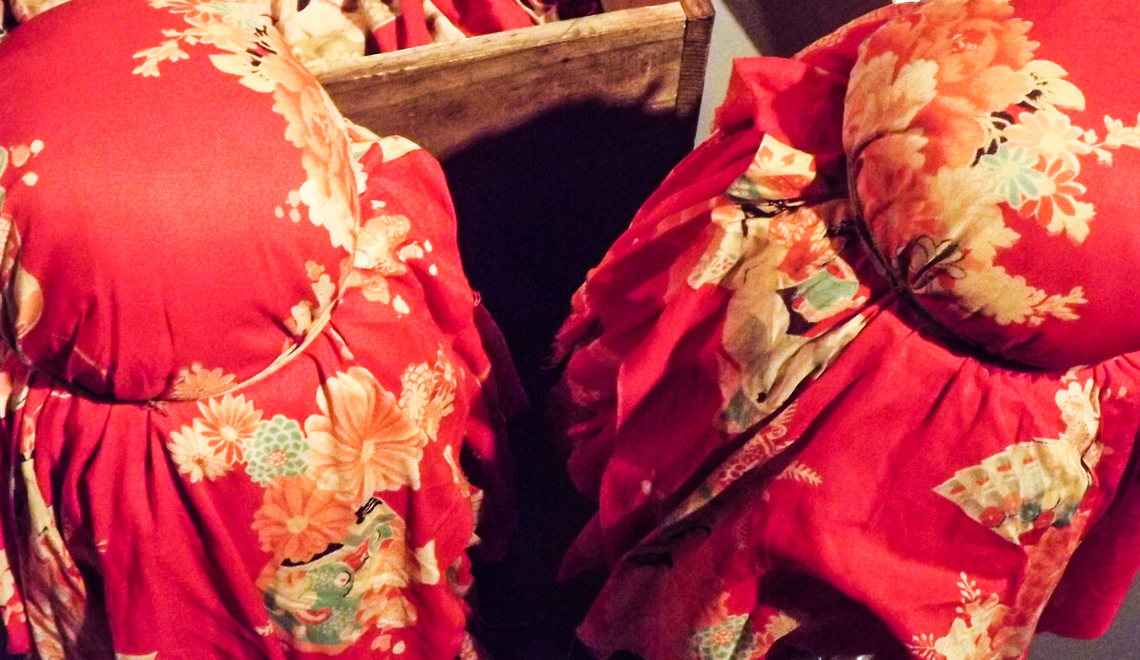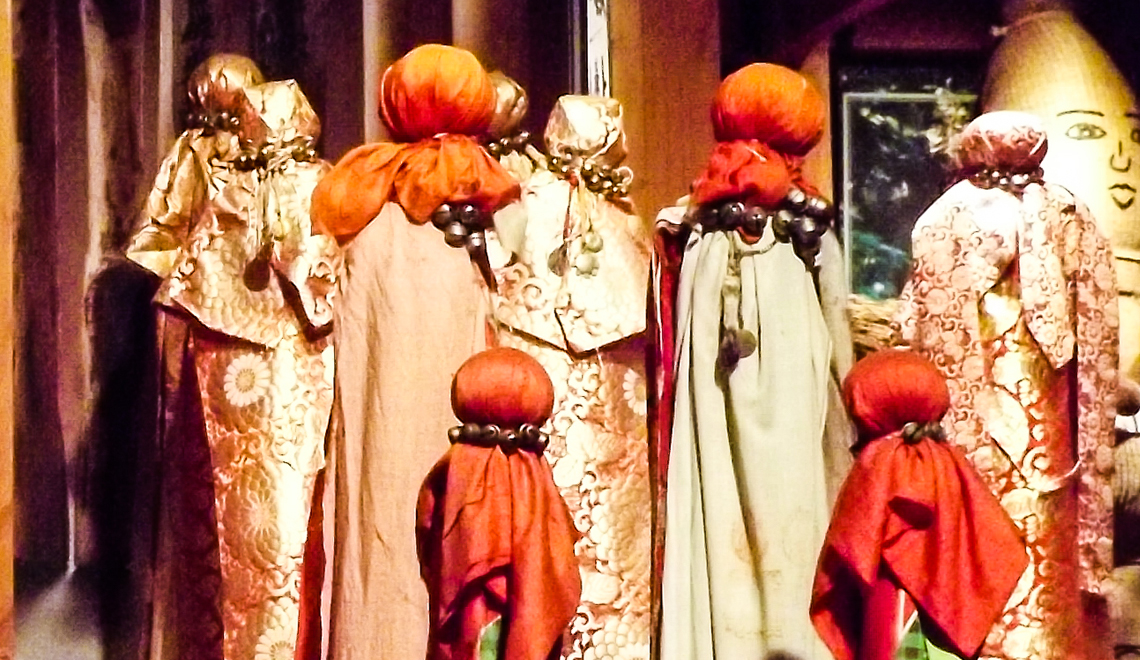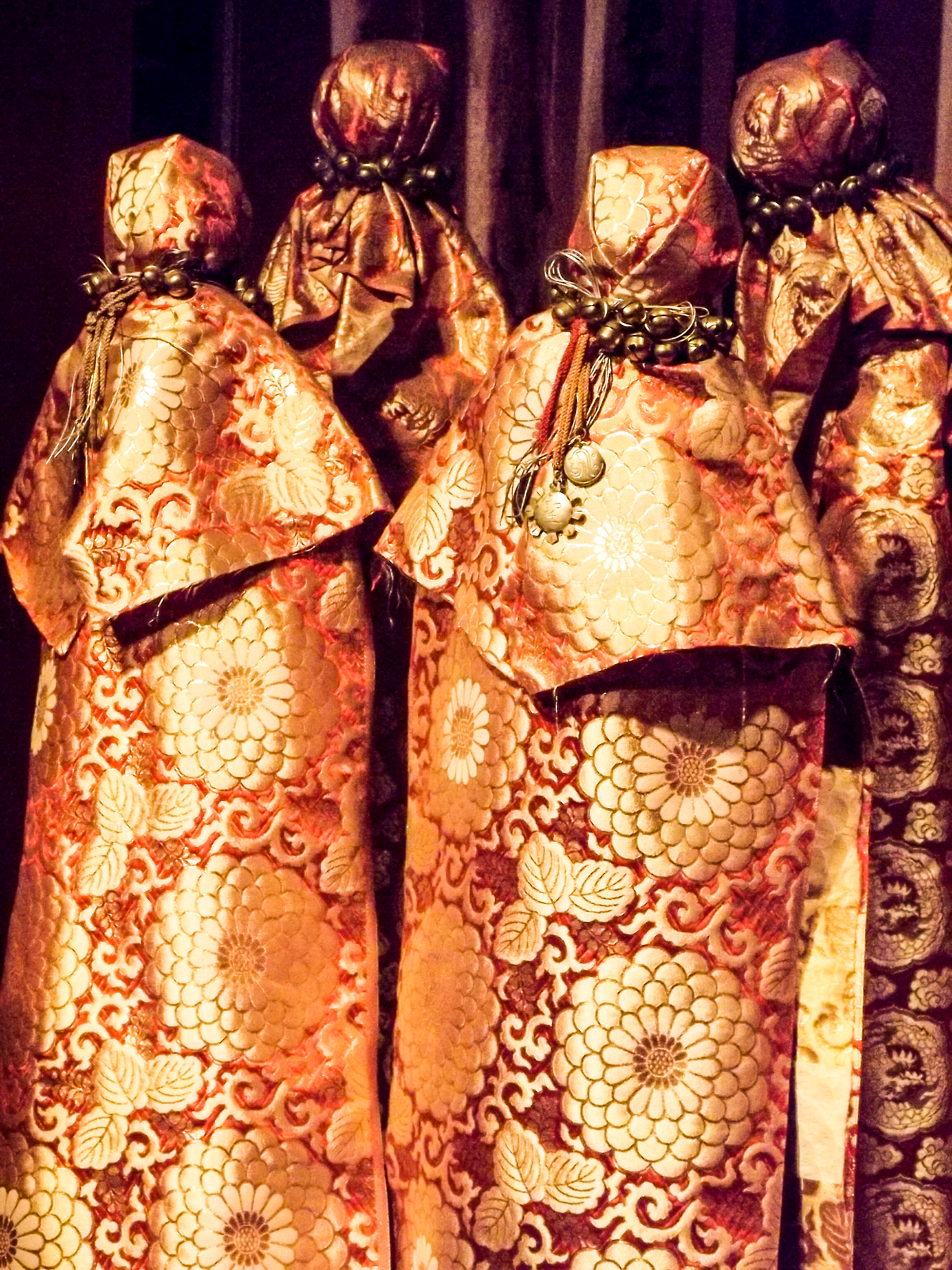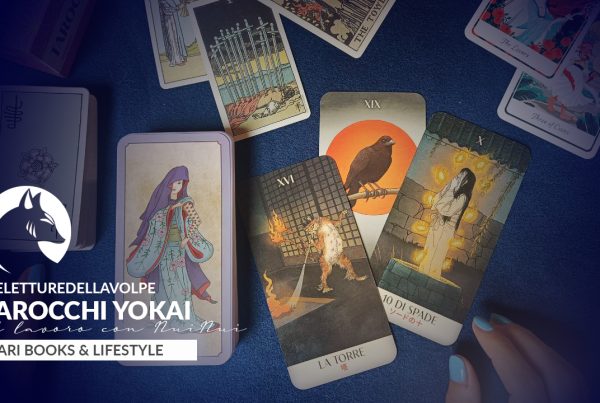In the abundance of the Japanese religions facts that I discovered in Japan, the shamans called itako are popular for the kuchiyose, the calling of the dead. However, the locals are still familiar with another – somewhat ancient – practice that itako still perform today: the Oshirasama – asobase. This is a very peculiar ritual in which the blind woman uses two wooden stick dressed and adorned with amazing fabrics, and that are supposed to represent a legendary girl Tamaya-goze, and her horse Sendankurige.
Little disclaimer: this is a very technical post about Japanese religions and traditions… a lot of specific language and citations are employed, so I can understand you if you feel sceptic about it, but I must warn you, the legend is incredible and it’s worth the reading.
What are Oshirasama in Japan

Picture taken in Spring 2013 at the Aomori Prefectural Folk Museum
Alain Miller offers an interesting analysis of the oshirasama
a pair of puppets representing in very crude fashion a horse and a woman. They are in fact sticks about a foot long with only the bulbous tops shaped. Thus they have a family resemblance both to the Shintō pillars and wands used to attract kami to festivals and into portable shrines, and to the Ainu inao or prayer sticks of similar purpose.
He also suggests a connection between oshirasama, kami, mountains and tall trees, as a sort of axis mundi connecting the heavenly world of kami with the human dimension; this can finds some corroboration in the idea that kami and spirits of the dead can sometimes take the shapes of birds. However, these shamanic implements, the oshirasama, are always “clothed”.
A japanese ritual song
Miller also analyzes the oshira-saimon, the ritual song that the itako sings while dancing and waiving the dolls; this song tells the story of Tamaya-gozen, and her horse Sedankurige (thousand-measure chestnut horse). Every day, Tamaya-gozen would take care of the horse, until finally they fell in love with each other; since the horse was getting sick, Tamaya-gozen’s father called in diviners to find out the source of the problem, and when he found out about the intense love between the daughter and the horse, full of rage, killed the horse and skinned him. Tamaya-gozen, devastate by the grief, went to pray in front of the skin, when suddenly it wrapped itself around the girl and flied in the sky with her. In that moment, a shower of black and white insect fell from the sky onto a mulberry tree, and begin eating their leafs: these are the first silkworms, and in consequence Tamaya-gozen’s family become the first silk merchant in the land.
A chinese origin for a japanese tradition

Picture taken in Spring 2013 at the Aomori Prefectural Folk Museum
This story has its original in a Chinese folktale, that goes under the title “The woman who married a horse”, extremly old; I include here the text translated by Miller
There is an old story that a very long time ago a great man left his family to go on a distant military campaign. There remained only a girl and a stallion. The girl cared for the stallion herself, as she was poor and in wretched circumstances. Thinking of her father, she jokingly said to the horse, “If you can find and bring back my father to me, I promise to marry you.” The horse responded to this speech by breaking out and galloping away. He came to where the father was. The father was surprised and happy to see the horse, so he caught and mounted him. The horse, looking in the direction from which he had come, whinnied ceaselessly. The father said, “This horse, being loose like this, the reason must be that all is not well at home.” He hastily rode the horse home. Because the beast was unusual the father was affectionate toward it, and consequently gave it generous amounts of hay. [But] the horse would not eat, [and] each time he caught a glimpse of the girl he would suddenly and passionately rear up and strike out, which happened many times. The father, suspicious, questioned his daughter in secret. The girl told him the entire truth about what must have been the cause of the horse’s behavior. The father said, “Do not speak of this, lest you disgrace the family, and do not let the horse see you.” Then, lying in ambush, he shot and killed [the horse] with an arrow. He then spread the hide out to dry in the courtyard and went away. The girl gave the hide to a neighbor girl and, stamping it with her feet, joked, “You are a beast, and yet you want a human being for your wife?” [The neighbor] took the hide, dressed it, and scraped it – but to what purpose? The purpose was not yet divulged: the horsehide seemed to creep along, then rose up, wrapped itself around the daughter, and went away. The neighbor became frightened, and, not 108As Miller pointed out, the story is also interpreted as an etiological legend explaining religious significance of the silk industry; the connection with the shamanistic practice is nonetheless very important, as we shall see. 83 daring to [attempt a] rescue, went and told the [first girl’s] father. The father searched for his daughter, asking everywhere, but he could not find her. After many days he came to a great tree. In its branches his daughter and the horsehide, both transformed into silkworms, were spinning [their cocoons]. The larvae spun thread continuously and in great abundance, unlike ordinary silkworms. The neighbor girl took them and cared for them, and their number increased greatly. Because of this the tree is called the mulberry; the mulberry tree is contained within them. For this reason the farmers all compete to plant it and to this day cultivate it. So-called “mulberry silkworms” are different from the silkworms of ancient times. When in early morning the horse star rises in the constellation T’ien-kuan (the heavenly official) according to the official reckoning, and, as the Book of Silkworms says, “When the moon occupies the constellation Da-huo (great fire), then wash the seeds [=eggs?].” This is because silkworms are present in horses; they are of the same essence [chi]. The Chou li [Book of rites] says, “They taught the people to manage the original silkworms properly.” A commentary says, “Each of two things cannot be dominant; the original silkworms were restrained because they cause injury to horses.” During Han times the empress herself performed a ritual in which she gathered mulberry [leaves] and made sacrifices to the Silkworm Deities, saying, “Lady Wanyin, Princess Yin!” “Princess” is of course a term of respect for a woman; Lady Wan-yin was the first [to care for] silkworms.
“The woman who married the horse” has three main axis of transformation: the horse and the girl into silkworms, the mulberry leaves in to silken thread and the silkworm into moths. The idea of transformation penetrates the whole tale, beginning with the dead horse who flies away with the girl, continuing with their transformation in silkworms, and finally ending with the leaves eaten by the silkworm and transformed in silk. The horsehide itself is the perfect symbol for the metamorphosis, since it covers the woman while the transformation takes place, like the silkworm contains the silk thread, and the cocoon contains the silkworm while it changes.
The girl and the horse in Japanese folk-religions
When this legend arrives to Japan, we witness some shifting in meaning.
There are here two elements in particular that deserve a attention: first of all, if it’s true that the killing of the horse is described in both the versions, in the Japanese one it is almost suggested, implied. Here the killing is just a narrative device, and it is not a means to symbolically reinforce the shamanic element: the importance does not reside in the ritual sacrifice but in the wrapping inside the animal skin and in the flight.
A second element is the origin of the silkworms: in the saimon, it is employed as a way to enhance the shamanic practice with a divine origine, while in the chinese version is more strictly connected with the introduction of the sericulture in the area. We can add some further elements: since in this divine wedding, the protagonist is the human girl (Tamaya-gozen) and the divine spose is the male horse, this allows us to suggest that this legend was carefully selected as a basis for the blind female practice
That this particular narrative with its divine-husband motif was in some sense a Japanese choise can be seen from the fact that the motif of shamanic flight was culturally available in Japan through the vectors of Taoism and Buddhism, but notably this was a role open only to men.
Alain Miller
Shaman’s Marginality in Japan

Picture taken in Spring 2013 at Aomori Prefectural Folk Museum
Moreover, we can see another characteristic of itako and blind fusha in general, in particular what Hori defines as senja ??, outcast
“Marginal” suggests a religious as well as a sociological category in that marginality in a variety of cultures has often been understood as a structural sine qua non of the appearance of the sacred. To exist on the marginal of social respectability is often seen as a necessary prerequisite to the exercise of the religiously vital function of mediating between sacred and profane realms
Alain Miller
In Japan we count a great number of senja (from geisha to dancers, from acrobats to fox breeders, funeral assistants, shamisen players, ecc.) and of course itako and minkan fusha; their marginality is undeniable and resides in their impurity, be it for contact with death, or with impure animals, or because they are phisically impared. As we saw, blindness incites exclusion; first of all because it obstructs the everyday life, and forces to chose from a narrow selection of activities.
READ MORE: My research | Female shamanism and impurity
Blindness, misconduct and the contact with the gods
Moreover, sometimes, blindness is bestowed a moral value, as in the case in which it’s interpreted as a karmic retribution, a legacy of previous errors or misconducts. On the other side, though, blindness can be given a complete different interpretation; it can be a necessary condition to enter in contact with a different, often forbidden dimension.
It can correspond to the initiatic sickness, the accidental element that symbolizes the person is chosen from the deities. We must bear in mind, moreover, that itako and other ogamisama are marginal figures also for another aspect: they are women, in a society where they must keep a secondary role, politically and socially, in respect with the men.
Elements such as the femininity of the protagonist, her poverty and her union with the animal can be connected to the marginal character of the minkan fusha: if it is true that poverty is an important element also in other religious practitioners such as monks, here it does not hold the liberating function that often has in different contexts.
The wedding with the animal, on one hand, sanctions the admittance to the sacred life (as the wedding banquet that follows the kamitsuke), and the transformation of the girl into a religious specialist; on the other hand, it determines the complete alienation of the woman who is now identify as an inhabitant of the grey zone between the human and the superhuman worlds. She is mirrored in the silkworms that, in the edge between animal and divine, allow the sacred substance (the mulberry) to transform and become part of the human world.
In the same way, the blind fusha is the means by which the sacred forces (too powerful for the ordinary human being) can be conveied and mediated, and the contact can become a communication between the two worlds.



